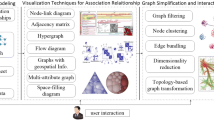Abstract
The original nonlinear dot plots were designed for dots of varying sizes by the two-way sweep algorithm. However, this algorithm uses the average of the starting point of the two-way sweep to determine the column position, which can lead to inaccurate position of the obtained data columns. Meanwhile, the two-way sweep algorithm has the shortcoming of unclear expression in high-density data area. In order to address this problem, we propose an improved nonlinear dot plot based on an undirected reassignment algorithm. The improved nonlinear dot plots can process and assign data in order to achieve an optimized layout that can identify the suitable dot position and data distribution. The proposed algorithm is more effective at displaying outliers and avoiding overlaps. Dots with large differences can be presented in the nonlinear dot plots. Our proposed method can further be combined with other data visualization attributions for data analysis purposes. Using a series of real datasets, the improved nonlinear dot plots are compared with both the conventional dot plots and the original nonlinear dot plots. Results show that our improved nonlinear dot plots not only allow for dots of varying sizes, but also clearly display the data with extremely high density.
Graphic abstract








Similar content being viewed by others
References
Arbesser C, Spechtenhauser F, Muhlbacher T, Piringer H (2017) Visplause: Visual data quality assessment of many time series using plausibility checks. IEEE Trans Visual Comput Graphics 23:641–650
Aupetit M, Heulot N, Fekete JA (2014) multidimensional brush for scatterplot data analytics, In: 2014 IEEE conference on visual analytics science and technology, pp 221–222
Bachthaler S, Weiskopf D (2008) Continuous scatterplots. IEEE Trans 100 Vis Comput Graphics 14:1428–1435
Bakker A (2004) Design research in statistics education: On symbolizing and computer tools, pp 243–276. Ph.D. thesis, Utrecht University
Borgo R, Dearden J, Jones MW (2014) Order of magnitude markers: an empirical study on large magnitude number detection. IEEE Trans Visual Comput Graphics 20:2261–2270
Chan YH, Correa CD, Ma KL (2013) The generalized sensitivity scatterplot. IEEE Trans Visual Comput Graphics 19:1768–1781
Chang K, Chiang C, Lee C (2010) A fast two-stage dynamic programming algorithm for change-points model with application in speech signal, In: 2010 Fourth international conference on genetic and evolutionary computing, pp 366–370
Chen H, Chen W, Mei H, Liu Z (2014) Visual abstraction and exploration of multi-class scatterplots. IEEE Trans Visual Comput Graphics 20:1683–1692
Copin Y, Cretton N, Emsellem E (2004) Axisymmetric dynamical models for sauron and oasis observations of ngc 3377. Astron Astrophys 415:889–903
Dang TN, Wilkinson L, Anand A (2011) Stacking graphic elements to avoid over-plotting. IEEE Trans Visual Comput Graphics 16:1044–1052
Haroz S, Kosara R, Franconeri SL (2016) The connected scatterplot for presenting paired time series. IEEE Trans Visual Comput Graphics 22:2174–2186
Hlawatsch M, Sadlo F, Burch M, Weiskopf D (2013) Scale-stack bar charts. Comput Graphics Forum 32:181–190
Isenberg P, Bezerianos A, Dragicevic P, Fekete JD (2011) A study on dual-scale data charts. IEEE Trans Visual Comput Graphics 17:2469–2478
Lander JP (2013) R for everyone: advanced analytics and graphics. Addison-Wesley Professional, Boston
Li J, Martens JB, Wijk JJV (2010) A model of symbol size discrimination in scatterplots, In: CHI ’10 Proceedings of the SIGCHI conference on human factors in computing systems, pp 2553–2562
Li J, Wijk JJV, Martens JB (2010) A model of symbol lightness discrimination in sparse scatterplots, In: 2010 IEEE pacific visualization symposium, pp 105–112
Ling L, Yinqing Z, Jingwen L (2007) Visualization of high dynamic range image with retinex algorithm, In: 2007 International symposium on microwave, antenna, propagation and emc technologies for wireless communications, pp 1215–1218
Padmi S, Russasmita IGA (2015) From sample to population: The use of dot plot to support the emergence of informal inferential reasoning. In: The third south east asia design/development research international conference, pp 314–324
Ramos JA (2005) Exponential data fitting applied to environmental data, In: 43rd IEEE conference on decision and control, pp 4169–4174
Rodrigues N, Weiskopf D (2018) Nonlinear dot plots. IEEE Trans 48 Vis Comput Graph 24:616–625
Sit ECY, Hu YJ (2015) A novel dot-plot algorithm for surface EMG signal segment identification. IEEE International Conference on Computational Intelligence and Virtual Environments for Measurement Systems an Applications pp 1–6
Tory M, Swindells C, Dreezer R (2009) Comparing dot and landscape spatializations for visual memory differences. IEEE Trans Visual Comput Graph 15:1033–1040
Wilkinson L (1999) Dot plots. Am Stat 53:276–281
Xiao Y, Wang X, Eshragh F, Wang X, Chen X, Fang D (2017) A study of pattern prediction in the monitoring data of earthen ruins with the internet of things. Sensors 17:1076
Yankov D, Keogh E, Lonardi S (2005) Dot plots for time series analysis, In: 17th IEEE international conference on tools with artificial intelligence, pp 158–168
Acknowledgements
This work was supported in part by the National Natural Science Foundation of China (No.61972315, 62072372), the International Cooperation and Exchange Program of Shaanxi Province (No. 2016KW-034) and The Key R&D Program-The Industry Project of Shaanxi (Grant No. 2017GY-191).
Author information
Authors and Affiliations
Corresponding author
Additional information
Publisher's Note
Springer Nature remains neutral with regard to jurisdictional claims in published maps and institutional affiliations.
Rights and permissions
About this article
Cite this article
Xiao, Y., Wang, C., Li, K. et al. A new nonlinear dot plots visualization based on an undirected reassignment algorithm. J Vis 24, 289–300 (2021). https://doi.org/10.1007/s12650-020-00711-5
Received:
Revised:
Accepted:
Published:
Issue Date:
DOI: https://doi.org/10.1007/s12650-020-00711-5




